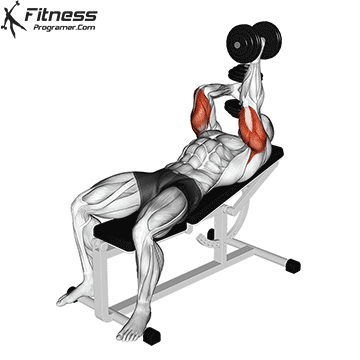Overview
This exercise is performed lying flat on a bench while holding a dumbbell in each hand. Unlike the traditional version, where both arms move simultaneously, this variation requires you to extend one arm at a time. It is especially effective for improving triceps symmetry and control, while reducing compensations often seen in bilateral lifts.
How to Perform

Lie flat on a bench with a dumbbell in each hand.
Extend both arms straight above your chest, palms facing each other.
Keep your elbows tucked in close to your torso.
Execution:
Lower one dumbbell by bending the elbow, bringing it toward your ear or shoulder level.
Keep the upper arm stationary and perpendicular to the floor.
Extend the arm back to the starting position by contracting the triceps.
Repeat on the opposite side, alternating arms each rep.
Complete the prescribed reps for both arms.
Breathing:
Inhale as you lower the dumbbell.
Exhale as you extend the arm back up.
Tips for Proper Form:
Keep your elbows fixed; avoid letting them flare out.
Move only at the elbow joint, not the shoulder.
Lower the weight slowly and under control to maintain tension.
Engage your core to keep the back flat against the bench.
Use a moderate weight to ensure control and full range of motion.
Common Mistakes to Avoid:
Flaring Elbows: Reduces triceps activation and increases shoulder involvement.
Using Too Much Weight: Can compromise form and increase injury risk.
Not Alternating Properly: Pausing too long or rushing between arms reduces tension.
Lifting With Momentum: Prevents proper isolation of the triceps.
Benefits
Unilateral Strength Development: Targets each triceps independently, helping correct imbalances.
Improved Control and Stability: Enhances joint stability and muscle coordination.
Increased Time Under Tension: Holding one dumbbell while working the other increases workload on both arms.
Greater Mind-Muscle Connection: Focused reps allow better muscle engagement.
Elbow-Friendly Variation: Allows natural arm path, reducing strain compared to fixed-bar exercises.
How to Incorporate Into Your Routine:
Placement: Use as a secondary movement on push or arm days. Ideal after compound lifts.
Reps and Sets:
Beginners: 2–3 sets of 8–10 reps per arm
Intermediate to advanced: 3–4 sets of 10–12 reps per arm
Pair With: Close-grip presses, overhead triceps extensions, or banded triceps pushdowns for volume.
Muscles Worked

